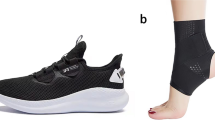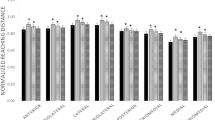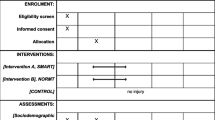Abstract
Sport injuries are unwanted adverse effects accompanying participation in sports. In a wide variety of sports the most common location of injury is the ankle, frequently resulting from a forced plantar flexed inversion of the foot exceeding the physiological range of motion (ROM). Historically the purpose of external support systems is to prevent acute ankle injuries by restricting abnormal ankle ROM. It is believed that a superior restrictive effect also implies a superior preventive effect.
The purpose of this review was to examine the literature regarding the restricting effect of adhesive taping, prophylactic ankle stabilisers (PAS) and high-top shoes on ankle ROM. It has been found that tape restricts ankle eversion and inversion ROM significantly following application. However, tape loosens significantly following standardised exercise and sports activities. Studies regarding PAS reported that both semi-rigid and nonrigid stabilisers give a significant post-application restriction of ankle inversion motion. The nonrigid stabilisers show loosening over time during exercise, while the semi-rigid stabilisers maintain their restrictive effect over the same time span. High-top shoes in comparison to low-top shoes are more effective in restricting mechanically imposed ankle inversion ROM. Low-top shoes, however, also limit mechanically imposed ankle inversion stress with the ankle in the position in which ankle injury occurs most frequently. One must keep in mind, however, that a superior mechanical restriction of ankle ROM does not necessarily imply a superior preventive effect. Only well-controlled randomised studies can show such an effect, and these studies have shown a reduction of ankle injury incidence for all 3 prophylactic measures reviewed.



Similar content being viewed by others
References
Pate RR, Pratt M, Blair SN, et al. Physical activity and public health: a recommendation from the Centers for Disease Control and Prevention and the American College of Sports Medicine. JAMA 1995; 273 (5): 402–7
Hutchinson MR. Cheerleading injuries: patterns, prevention, case reports. Phys Sports Med 1997; 25 (9): 83–96
Wexler FK. The injured ankle. Am Fam Physician 1988; 57 (3): 474–80
Bylak J, Hutchinson MR. Common sports injuries in young tennis players. Sports Med 1998; 26 (2): 119–32
Creagh U, Reilly T. Training and injuries amongst elite female orienteers. J Sports Med Phys Fitness 1998; 38 (1): 75–9
Bahr R, Bahr IA. Incidence of acute volleyball injuries: a prospective cohort study of injury mechanisms and risk factors. Scand J Med Sci Sports 1997; 7 (3): 166–71
Maehlum S, Daljord OA. Acute sports injuries in Oslo: a oneyear study. Br J Sports Med 1984; 18 (3): 181–5
Wikstrom J, Andersson C. A prospective study of injuries in licensed floorball players. Scand J Med Sci Sports 1997; 7 (1): 38–42
Callaghan MJ. Role of ankle taping and bracing in the athlete. Br J Sports Med 1997; 31 (2): 102–8
Garrick JG. The frequency of injury, mechanism of injury, and epidemiology of ankle sprains. Am J Sports Med 1977; 5 (6): 241–5
Bahr R, Lian Ø, Bahr IA. A twofold reduction in the incidence of acute ankle sprains in volleyball after the introduction of an injury prevention program: a prospective cohort study. Scand J Med Sci Sports 1997; 7 (3): 172–7
Barrett J, Bilisko T. The role of shoes in the prevention of ankle sprains. Sports Med 1995; 20 (4): 277–80
Laughman RK, Carr TA, Chao EY, et al. Three-dimensional kinematics of the taped ankle before and after exercise. Am J Sports Med 1980; 8 (6): 425–31
Yamamoto T, Kigawa A, Xu T. Effectiveness of functional ankle taping for judo athletes: a comparison between judo bandaging and taping. Br J Sports Med 1993; 27 (2): 110–2
Ekstrand J, Gillquist J. Soccer injuries and their mechanisms: a prospective study. Med Sci Sports Exerc 1983; 15 (3): 267–70
Rovere GD, Clarke TJ, Yates CS, et al. Retrospective comparison of taping and ankle stabilizers in preventing ankle injuries. Am J Sports Med 1988; 16 (3): 228–33
Delacerda FG. Effect of under wrap conditions on the supportive effectiveness of ankle strapping with tape. J Sports Med Phys Fitness 1978; 18 (1): 77–81
Tropp H, Askling C, Gillquist J. Prevention of ankle sprains. Am J Sports Med 1985; 13 (4): 259–62
Gross MT, Bradshaw MK, Ventry LC, et al. Comparison of support provided by ankle taping and semirigid orthosis. J Orthop Sports Phys Ther 1987; 9 (1): 33–9
Lyle TD, Corbin CB. Restriction of ankle inversion: taping versus an ankle brace. Phys Educ 1992; 49 (2): 88–94
Martin N, Harter RA. Comparison of inversion restraint provided by ankle prophylactic devices before and after exercise. J Athlet Train 1993; 28 (4): 324–9
Baer H. The effect of high top and low cut football shoes on speed and agility. Athlet J 1970; 50: 74–7
Johnson GR, Dowson D, Wright V. A biomechanical approach to the design of football boots. J Biomech 1976; 9 (9): 581–5
Stacoff A, Stuessi E, Sonderegger D. Lateral stability of sports shoes. Calgary (AB): University of Calgary, 1983
Greene TA, Hillman SK. Comparison of support provided by a semirigid orthosis and adhesive ankle taping before, during, and after exercise. Am J Sports Med 1990; 18 (5): 498–506
Myburgh KH, Vaughan CL, Isaacs SK. The effects of ankle guards and taping on joint motion before, during, and after a squash match. Am J Sports Med 1984; 12 (6): 441–6
Manfroy PP, Ashton-Miller JA, Wojtys EM. The effect of exercise, prewrap, and athletic tape on the maximal active and passive ankle resistance of ankle inversion. Am J Sports Med 1997; 25 (2): 156–63
Gross MT, Lapp AK, Davis JM. Comparison of Swede-O Universal Ankle Support and Aircast Sport-Stirrup orthoses and ankle tape in restricting eversion-inversion before and after exercise. J Orthop Sports Phys Ther 1991; 13 (1); 11–9
Glick JM, Gordon RB, Nishimoto D. The prevention and treatment of ankle injuries. Am J Sports Med 1976; 4 (4): 136–41
Sitler MR, Horodyski M. Effectiveness of prophylactic ankle stabilisers for prevention of ankle injuries. Sports Med 1995; 20 (1): 53–7
Greene TA, Wight CR. A comparative support evaluation of three ankle orthoses before, during, and after exercise. J Orthop Sports Phys Ther 1990; 11 (10): 453–66
Fumich RM, Ellison AE, Guerin GJ, et al. The measured effect of taping on combined foot and ankle motion before and after exercise. Am J Sports Med 1981; 9 (3): 165–70
Stover CN. Air Stirrup management of ankle injuries in the athlete. Am J Sports Med 1980; 8: 360–5
Wiley JP, Nigg BM. The effect of an ankle orthosis on ankle range of motion and performance. J Orthop Sports Phys Ther 1996; 23 (6): 362–9
Anderson DL, Sanderson DJ, Hennig EM. The role of external nonrigid ankle bracing in limiting ankle inversion. Clin J Sport Med 1995; 5 (1): 18–24
Tweedy R, Carson T, Vicenzino B. Leuko and Nessa ankle braces: effectiveness before and after exercise. Aust J Sci Med Sport 1994; 26 (3–4): 62–6
Ashton-Miller JA, Ottaviani RA, Hutchinson C, et al. What best protects the inverted weight bearing ankle against further inversion? Evertor muscle strength compares favorably with shoe height, athletic tape, and three orthoses. Am J Sports Med 1996; 24 (6): 800–9
Greene TA, Roland GC. A comparative isokinetic evaluation of a functional ankle orthosis on talocalcaneal function. J Orthop Sports Ther 1989; 11 (6): 245–52
Ottaviani RA, Ashton-Miller JA, Kothari SU, et al. Basketball shoe height and the maximal muscular resistance to applied ankle inversion and eversion moments. AmJ Sports Med 1995; 23 (4): 418–23
Verhagen EALM, van Mechelen W, de Vente W. The effect of preventive measures on the incidence of lateral ligament injury of the ankle. Clin J Sports Med 2000; 10 (4): 291–6
Garrick JG, Requa RK. Role of external support in the prevention of ankle sprains. Med Sci Sports 1973; 5 (3): 200–3
Surve I, Schwellnus MP, Noakes T, et al. A fivefold reduction in the incidence of recurrent ankle sprains in soccer players using the Sport-Stirrup orthosis. Am J Sports Med 1994; 22 (5): 601–6
Amoroso PJ, Ryan JB, Bickley B, et al. Braced for impact: reducing military paratroopers’ ankle sprains using outside the- boot braces. J Trauma 1998; 45 (3): 575–80
Sitler M, Ryan J, Wheeler B, et al. The efficacy of a semirigid ankle stabilizer to reduce acute ankle injuries in basketball: a randomized clinical study at West Point. Am J Sports Med 1994; 22 (4): 454–61
Barrett JR, Tanji JL, Drake C, et al. High- versus low-top shoes for the prevention of ankle sprains in basketball players: a prospective randomized study. Am J Sports Med 1993; 21 (4): 582–5
Robbins S, Waked E, Rappel R. Ankle taping improves proprioception before and after exercise in young men. Br J Sports Med 1995; 9 (4): 242–7
Acknowledgements
Financial support for this study was kindly granted by the Dutch Health Research and Development Council (Z0N).
Author information
Authors and Affiliations
Rights and permissions
About this article
Cite this article
Verhagen, E.A.L.M., van der Beek, A.J. & van Mechelen, W. The Effect of Tape, Braces and Shoes on Ankle Range of Motion. Sports Med 31, 667–677 (2001). https://doi.org/10.2165/00007256-200131090-00003
Published:
Issue Date:
DOI: https://doi.org/10.2165/00007256-200131090-00003




